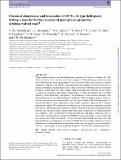Chemical abundances and kinematics of 257 G-, K-type field giants. Setting a base for further analysis of giant-planet properties orbiting evolved stars
Abstract
We performed a uniform and detailed abundance analysis of 12 refractory elements (Na, Mg, Al, Si, Ca, Ti, Cr, Ni, Co, Sc, Mn, and V) for a sample of 257 G- and K-type evolved stars from the CORALIE planet search programme. To date, only one of these stars is known to harbour a planetary companion. We aimed to characterize this large sample of evolved stars in terms of chemical abundances and kinematics, thus setting a solid base for further analysis of planetary properties around giant stars. This sample, being homogeneously analysed, can be used as a comparison sample for other planet-related studies, as well as for different type of studies related to stellar and Galaxy astrophysics. The abundances of the chemical elements were determined using an local thermodynamic equilibrium (LTE) abundance analysis relative to the Sun, with the spectral synthesis code MOOG and a grid of Kurucz ATLAS9 atmospheres. To separate the Galactic stellar populations, both a purely kinematical approach and a chemical method were applied. We confirm the overabundance of Na in giant stars compared to the field FGK dwarfs. This enhancement might have a stellar evolutionary character, but departures from LTE may also produce a similar enhancement. Our chemical separation of stellar populations also suggests a `gap' in metallicity between the thick-disc and high-α metal-rich stars, as previously observed in dwarfs sample from HARPS. The present sample, as most of the giant star samples, also suffers from the B - V colour cut-off, which excludes low-log g stars with high metallicities, and high-log g star with low [Fe/H]. For future studies of planet occurrence dependence on stellar metallicity around these evolved stars, we suggest to use a subsample of stars in a `cut-rectangle' in the log g-[Fe/H] diagram to overcome the aforementioned issue.
Citation
Adibekyan , V Z , Benamati , L , Santos , N C , Alves , S , Lovis , C , Udry , S , Israelian , G , Sousa , S G , Tsantaki , M , Mortier , A , Sozzetti , A & De Medeiros , J R 2015 , ' Chemical abundances and kinematics of 257 G-, K-type field giants. Setting a base for further analysis of giant-planet properties orbiting evolved stars ' , Monthly Notices of the Royal Astronomical Society , vol. 450 , pp. 1900-1915 . https://doi.org/10.1093/mnras/stv716
Publication
Monthly Notices of the Royal Astronomical Society
Status
Peer reviewed
ISSN
0035-8711Type
Journal article
Description
This work was supported by the European Research Council/European Community under the FP7 through Starting Grant agreement number 239953. This work was also supported by the Gaia Research for European Astronomy Training (GREATITN) Marie Curie network, funded through the European Union Seventh Framework Programme ([FP7/2007-2013]) under grant agreement number 264895. V.Zh.A. and S.G.S acknowledge the support from the Fundação para a Ciência e a Tecnologia, FCT (Portugal) in the form of the fellowships SFRH/BPD/70574/2010 and SFRH/BPD/47611/2008, respectively. NCS was supported by FCT through the Investigator FCT contract reference IF/00169/2012 and POPH/FSE (EC) by FEDER funding through the programme ‘Programa Operacional de Factores de Competitividade’ – COMPETE. SA acknowledges Post-Doctoral Fellowship from the CAPES brazilian agency (BEX-2077140), and also support by Iniciativa Científica Milenio through grant IC120009, awarded to The Millennium Institute of Astrophysics. GI acknowledges financial support from the Spanish Ministry project MINECO AYA2011-29060. AM received funding from the European Union Seventh Framework Programme (FP7/2007-2013) under grant agreement number 313014 (ETAEARTH).Collections
Items in the St Andrews Research Repository are protected by copyright, with all rights reserved, unless otherwise indicated.

